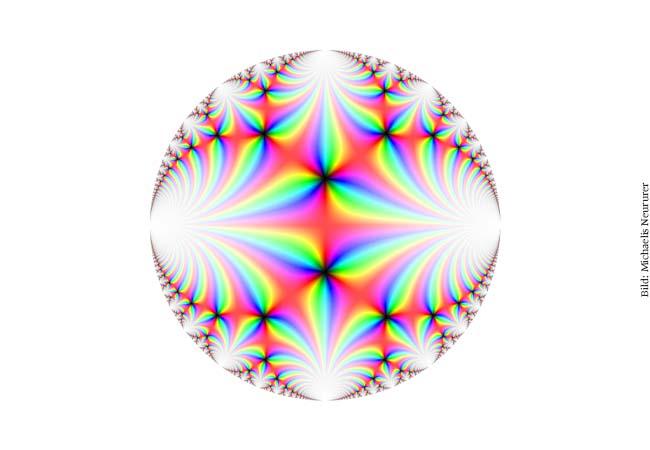German Research Foundation funds new CRC Transregio 326 „Geometry and arithmetic of uniformized structures” – CRC 1039 on medical signal path research enters third funding period – Goethe University involved in two further CRC-Transregios
Researching intricate geometric and arithmetic objects is the goal of the new Collaborative Research Centre Transregio 326 (TRR 326), coordinated by Goethe University. On 25th May, the German Research Foundation (DFG) announced that the TRR 326 would be funded with 9.2 million euros for the next four years. The CRC 1039 “Signalling by fatty acid derivatives and sphingolipids in health and disease”, for which Goethe University is spokesperson, will be continued and receive 9.6 million euros for the third funding period. Two other TRRs in which Goethe University is involved will also be funded by the DFG: In the TRR 211 “Strongly interacting matter under extreme conditions”, the spokesperson will switch from Goethe University to the Technical University of Darmstadt (9.2 million euros). Finally, scientists from Goethe University are also significantly involved in TRR 301 “The tropopause region in a changing atmosphere” (spokesperson: Johannes Gutenberg University Mainz, €12.3 million).
FRANKFURT. Professor Enrico Schleiff, President of Goethe University Frankfurt, congratulates the scientists on their success: “Goethe University’s commitment, particularly in the Transregio Collaborative Research Centres, demonstrates our excellent scientific networking in the region, especially in the natural sciences and medicine. The association of the Rhine-Main universities of Frankfurt, Mainz and Darmstadt, have given this regional cooperation a framework: There are now more than 30 research associations and networks in this strategic alliance, and last year we established the RMU degree programme so that talented students can also benefit from RMU.”
The mathematical exploration of complicated geometric and arithmetic spaces with the help of uniformization is the research topic of TRR 326 “Geometry and arithmetic of uniformized structures – GAUS”. Together with coordinator Goethe University Frankfurt, the Technical University of Darmstadt and Heidelberg University successfully applied for TRR 326; associated institutions are the Johannes Gutenberg University Mainz and the Technical University of Munich. The concept of uniformization goes back to ideas of Felix Klein and Henri Poincaré from the 19th century and seeks a uniform description of certain geometric objects. A very simple example uniformization can be illustrated with the slinky, a metal spiral toy which is able to “run” down a staircase doing “somersaults”. When pressed together, it has – seen from above – the geometry of a circle. This circle can be uniformized by pulling the metal spiral apart. It becomes particularly simple when the spiral is completely unwound and, geometrically, is only a simple wire. In order to preserve the information of the slinky, each spiral turn on the wire is marked with a colour dot, which gives the wire a shifting symmetry (you change levels in the spiral). A globally complicated geometric space (in our example, the circle of the slinky) is replaced by a much simpler space (here a straight line) without changing the local structure. The original complexity is described by internal symmetries (illustrated in the example by periodic markings) of the simpler space.
In TRR 326 GAUS, mathematicians deal with uniformization of very complicated geometric spaces – this includes modern geometric concepts, in particular tropical and p-adic geometries – and with analogous applications of the uniformization technique to arithmetic (number-theoretic) questions. Here, the researchers try to identify fundamental connections, for example to moduli spaces, automorphic forms, Galois representations, and cohomological structures. Professor Jakob Stix, mathematician at Goethe University and GAUS spokesman, says: “With the SFB Transregio GAUS, we are building on the extremely successful collaboration between TU Darmstadt and Goethe University in the LOEWE priority ‘Uniformed Structures in Arithmetic and Geometry’ and the DFG research group ‘Symmetry, Geometry and Arithmetic’ at TU Darmstadt and Heidelberg University. I am very much looking forward to doing joint research with so many outstanding colleagues.”
The Collaborative Research Centre 1039 “Signalling by fatty acid derivatives and sphingolipids in health and disease,” which Goethe University is now continuing together with the Max Planck Institute for Heart and Lung Research in Bad Nauheim, is entering its third funding period. The scientists are studying a group of poorly water-soluble biomolecules, the lipids. As lipid bilayers, they prominently form the membranes that surround our cells and also divide the interior of the cells. As fats, they serve as energy storage for our bodies.
However, CRC 1039 is investigating a function that is still comparatively under-researched: Lipids are part of many signalling pathways through which cells regulate growth and metabolism and communicate with their environment. Dysregulated lipids are apparently decisively involved in the development and progression of diseases such as diabetes, cancer, inflammation, and neurodegenerative diseases. After fundamental work in the first two funding periods, the third funding period focuses on understanding the whole organism. Professor Josef Pfeilschifter, pharmacologist at Goethe University and spokesman of SFB 1039, explains: “We want to understand the lipid signalling network as a whole and thus develop innovative ways to diagnose and treat a wide variety of diseases related to dysregulated lipids. In doing so, we can rely on a long-standing and broad expertise in ‘lipid signalling’, which is also founded on the establishment of sophisticated analytical methods based on mass spectrometry.”
Scientists from Goethe University are significantly involved in two other CRC Transregios:
How matter behaves under conditions of extreme pressure and temperature, in which atoms overlap and fuse with each other is being investigated by TRR 211 “Strongly interacting matter under extreme conditions”, which is entering its second funding period. For extremely short periods of time, such states of matter can be created in particle accelerators, revealing something about the strong interaction that holds atomic nuclei together. In the cosmos, such extreme states of matter occur when, for example, neutron stars collide with each other. BesidesGoethe University, the Technical University of Darmstadt, which is the new host university, and Bielefeld University are also involved in this collaborative research centre.
In the new TRR 301 “The tropopause region in a changing atmosphere”, atmospheric scientists will study the tropopause region: the zone in the atmosphere that separates the lower “weather layer” (troposphere) from the stratosphere above. The research focus is on the physical and chemical processes of this region and their influence on planetary circulation and climate. The main locations are the Johannes Gutenberg University Mainz (spokesperson) and Goethe University Frankfurt. Also involved are the Technical University of Darmstadt, the Ludwig Maximilian University of Munich, the Max Planck Institute for Chemistry in Mainz, the Jülich Research Centre and the German Aerospace Centre (DLR) in Oberpfaffenhofen.
###
Media Contact
Professor Jakob Stix
[email protected]
Original Source
https:/





